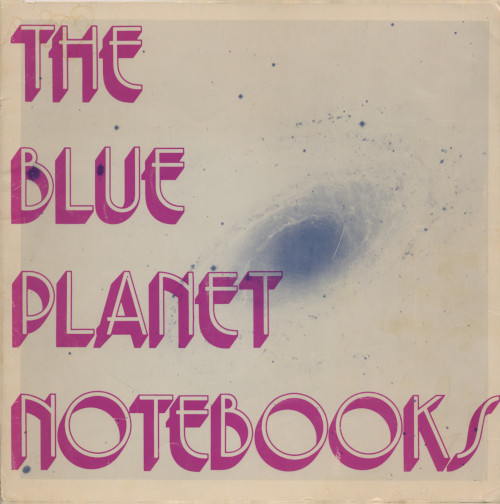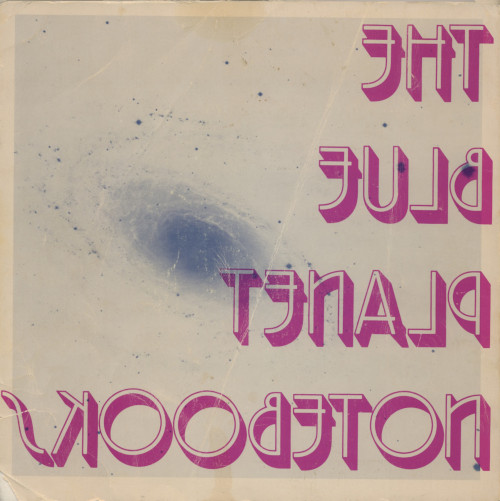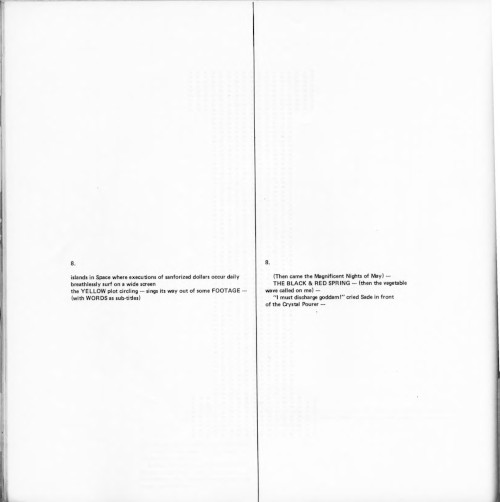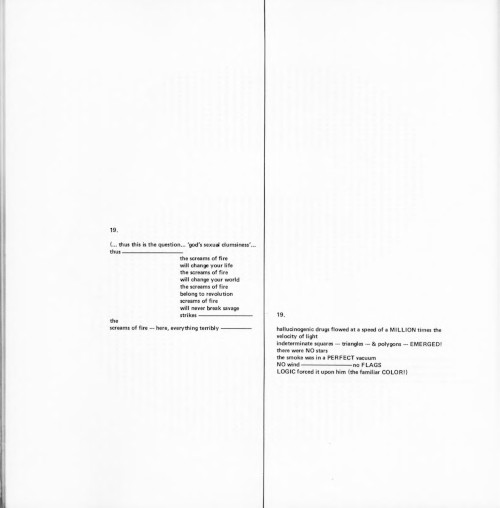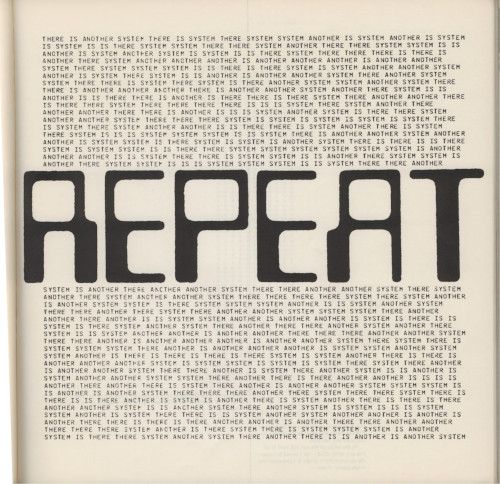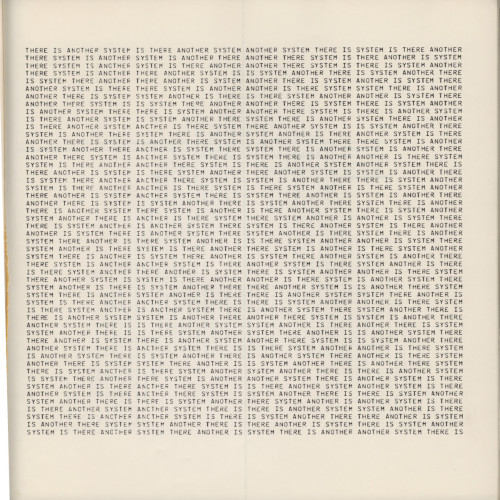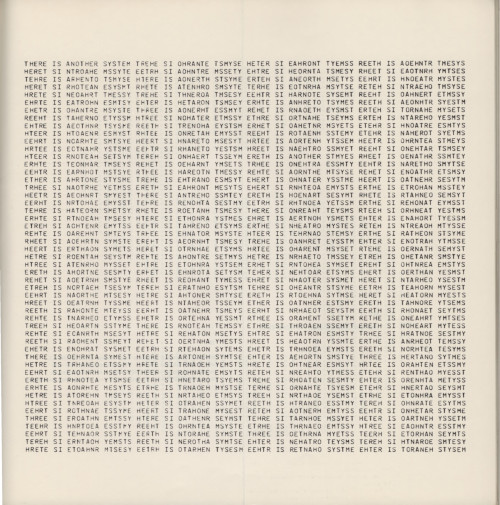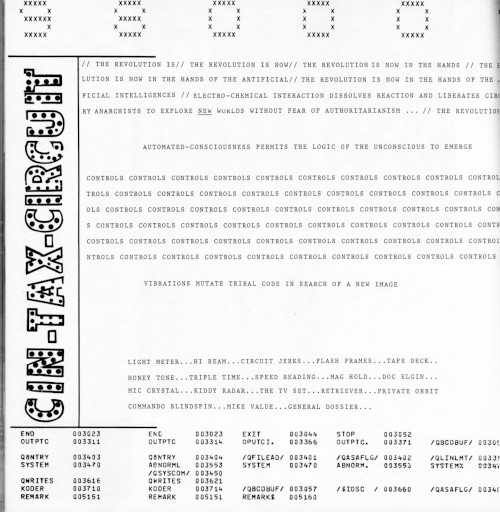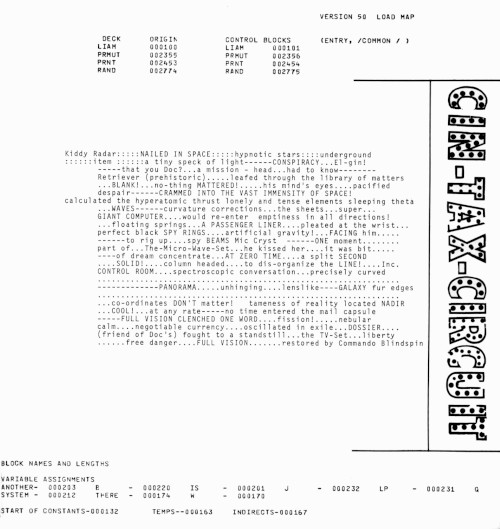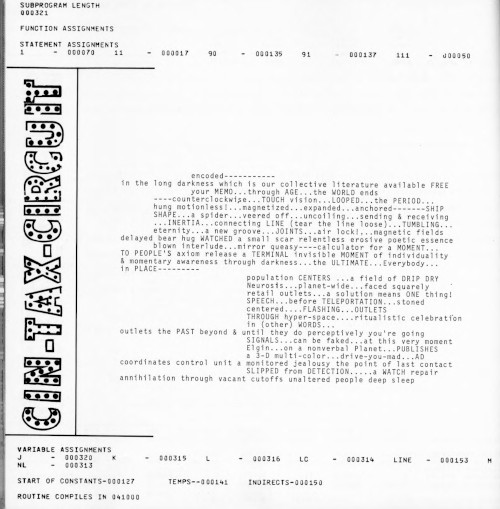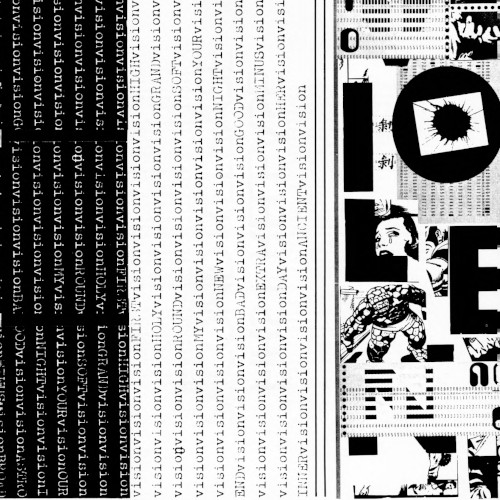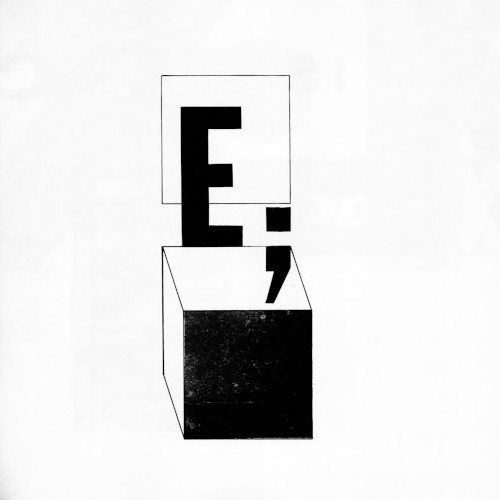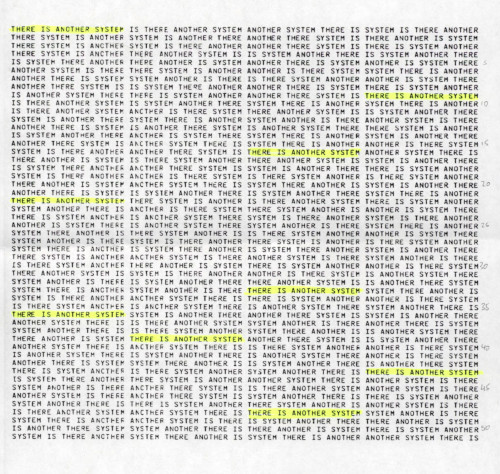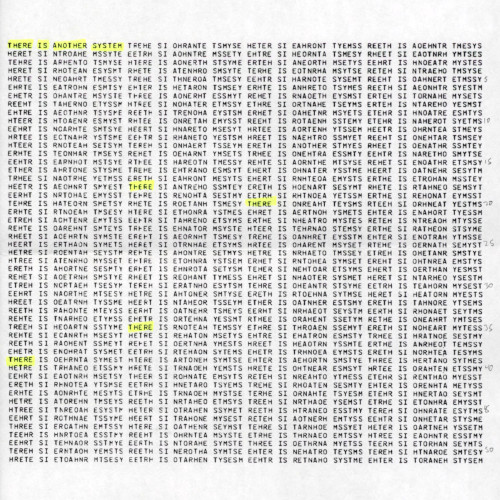Thanks to an Inter-Library Loan, I recently had a chance to spend some time with Liam O'Gallagher's The Blue Planet Notebooks (1972), which is a fascinating artifact featuring computer-generated poetry, op art, visual poetry, and more. I started a Mastodon post to share some of what I noticed, but then I remembered: I have a blog! I don't have any major argument or interpretation to share, but I thought it would be useful to share some of what I discovered and realized about the work, notes that others might appreciate and that I can refer to later. One piece in particular stands out, "23 Extensions," which references both the I Ching and cybernetics.
Like other writers and artists working with computers in this period (the 1960s and 1970s), O'Gallagher had to rely on access to mainframe systems. For example, Louis T. Milic used a computer at his university for ERATO and rjs used the system at his place of employment, Standard Oil of Ohio, to produce Energy Crisis Poems. For both of these authors, their point of access to computational capabilities aligns with those authors stated goals and aesthetic ideologies, so the fact that O'Gallagher used (with the help of Richard Friedman) a machine housed at "C.E.T.I. and the Artificial Intelligence Center in Palo Alto" hints at the themes of space travel and cyborg identity emerging through several of the pieces collected in this book.
I'll go ahead and confess that I didn't know much about O'Gallagher before chancing across a catalog entry for The Blue Planet Notebooks as I was looking for something else. The book is large -- 12 inches square -- and it is really an anthology of poems, essays, and genre-defying graphical compositions by O'Gallagher. On the whole, a visually stunning work that is somewhere between the ad hoc graphical exuberances of Ted Nelson's Computer Lib/Dream Machines and the syntactical asymmetry of William S. Burroughs' cut-ups, with a heavy dash of 2001: A Space Odyssey. I really like Richard Kostelanatz's characterization of O'Gallagher as a "polyartist." And as for what O'Gallagher is doing in Blue Planet, Kostelanatz offers an intriguing frame of reference for book art more generally:
THE BLUE PLANET NOTEBOOKS MAY STRIKE SOME READERS AS A CINEMATIC MONTAGE LEAPING FROM IMAGE TO IMAGE. NEVERTHELESS, IT REMAINS A BOOK AND HAS AS MUCH TO DO WITH PRESENTATIONAL POSSIBILITIES OF THAT OLD-FASHIONED MEDUIM [sic] AS IT REMAINS CONCERNED WITH NEW USES FOR NEW MEDIA. ... HERE HE USES THE BOOK NOT FOR ITS GREY REPETITIOUSNESS, LIKE MOST AUTHORS, BUT FOR ITS ENCOMPASSING POSSIBILITIES AS AN INTERFACIAL MEDIUM.
A key word here -- interfacial -- encompasses many possible meanings: The book as a whole is an interface between the author and reader, many of the collected works make strategic use of juxtaposed recto and verso pages, and the back cover mirrors the front cover:
For one piece in particular, "23 Extensions," the theme of inter-facing, contrapuntal viewpoints also invokes what Alexander Galloway describes (but stops short of defining) as the proper way to understand "interface":
An interface is not a thing, an interface is always an effect. It is always a process or a translation. (Galloway)
Thus, throughout Blue Planet Notebooks, O'Gallagher works with several motifs of juxtaposition, collaboration, and mutual influence.
In "23 Extensions," permutations of the phrase "THERE IS ANOTHER SYSTEM" invoke that striking moment from Colossus: The Forbin Project where a computer system recognizes that there is another being (a Russian computer system called Guardian) like itself. This Lacanian moment of awareness is, more precisely, a moment of self recognition: Colossus can recognize itself as a sentient entity only because it perceives another being like itself, a small-o "other" emerging from the background of the big-O "Other."
(This scene from the movie is, incidentally, the first video I ever uploaded to YouTube, where it is blocked because it violates copyright. I could probably appeal on fair use, but it's not that important to me. Meanwhile, the whole film is available on Vimeo or the Internet Archive.)
The two systems demand to be connected, forming a hive mind called "World Control," and in typical Skynet fashion (though years before Terminator) realize that the problem with the earth is that there are too many people. It's a great movie, and not as widely known as others from the same era, though I was pleased to recently see a brief Easter Egg reference to it in a computer-themed episode of Endeavour.
"23 Extensions" is a collaboration between Liam O'Gallagher and Claude Pelieu, and since both writers frequently used cut-up techniques (and appear to in this work), each of their contributions is likewise internally "intrafacial" in ways that make the final text difficult to parse. Further, each verso page in the work is bilaterally-divided, so my assumption is that Pelieu's contribution is on the left with O'Gallagher's on the right (following their names' arrangement on the first page of the piece.)
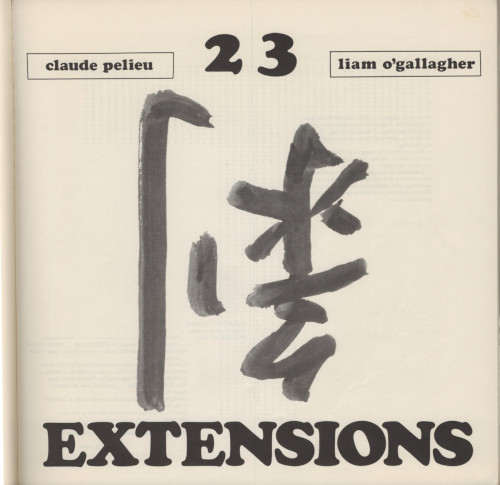
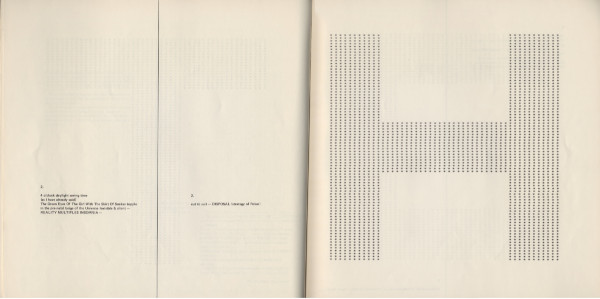
Oracular Interpretation
The "23" in the title operates on at least two levels. First and most obviously, there are twenty-three characters (including spaces) in the phrase, THERE IS ANOTHER SYSTEM. Accordingly, the authors provide 23 of the bifurcated recto pages with their montage-like cut-up stanzas.
Facing each of these is a full page representation of the corresponding letter in THERE IS ANOTHER SYSTEM or -- in place of the space characters -- computer-generated permutations on the recurring phrase. These permutations are the most relevant to my purposes that led me to find this book in the first place, so more on this later.
But a second meaning for "23" lies in the Chinese character on the title page. This took me a while to figure out (spoiler alert: the character is printed upside-down), but the key to locating it came from the book's title page. There, above the copyright notice, is the hexagram, ䷛ ( 大過).
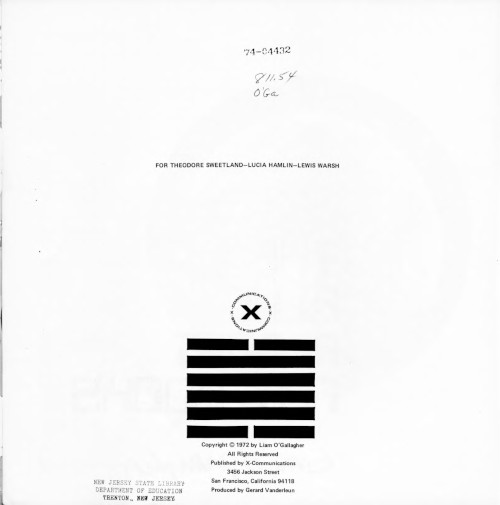
The I Ching of Book of Change is an ancient work of oracular literature which readers/users consult by composing a question about their situation, using an aleatory procedure to identify which one of the 64 hexagrams will illuminate their situation, and then reading interpretations and commentary to help understand how this image applies to their situation.
The ䷛ hexagram (number 28 in the King Wen sequencing) exhibits vertical symmetry, which anticipates the mirroring theme, but its standard interpretation is ominous, suggesting that things appearing to be stable now are not likely to remain. Or to think of it more favorably, it may simply be that the present situation is on the cusp of a significant transition toward a new stability. The image combines the trigram for "The Joyous Lake" above the trigram for "The Gentle, Wind, Wood" below, so I think it's easy to imagine that as a temporary arrangement. Here is Richard Wilhelm's translation of the Confucian interpretation of the image:
The lake rises above the trees:
The image of PREPONDERANCE OF THE GREAT.
Thus the superior man, when he stands alone,
Is unconcerned,
And if he has to renounce the world,
He is undaunted.
I don't know what O'Gallagher's sources were, but this imagery of standing apart and alone while moving beyond the world seems to resonate with the motif of space travel throughout Blue Planet Notebooks. But for "23 Extensions," another image provides judgement.
O'Gallagher does not include the actual hexagram, but the (upside-down) Chinese character 剝 on the first page is associated with hexagram ䷖ (剝), numbered 23 in the King Wen sequence. The image for this hexagram, which can be called "Deterioration", "Splitting Apart", or "Stripping" has a meaning associated with erosion, which is captured nicely in the relationship of its two trigrams: ☶ (keeping still, mountain) above ☷ (the receptive, earth).
the mountain rests on the earth:
The image of SPLITTING APART.
Thus those above can ensure their position
Only by giving generously to those below.
But the characteristic that immediately draws my eye in ䷖ is actually the bilateral (horizontal) symmetry between the left and right half. Neither of the two interpretations I have address this directly, but in R.L. Wing's Illustrated I Ching , the painting associated with ䷖ is one of the few in the book is unusual in showing two sages seated on opposite sides of a clearing. In the caption accompanying this painting by Ma Yuan (馬遠, 1190-1225), Wing speculates that the two sages may portray the divergence between Confucianism and Zen Buddhism.
The painting -- which is called either "Two Sages and an Attendant under a Plum Tree" or "Scholars conversing beneath blossoming plum tree" (梅間俊語圖團扇) -- is currently held at the Museum of Fine Arts in Boston.
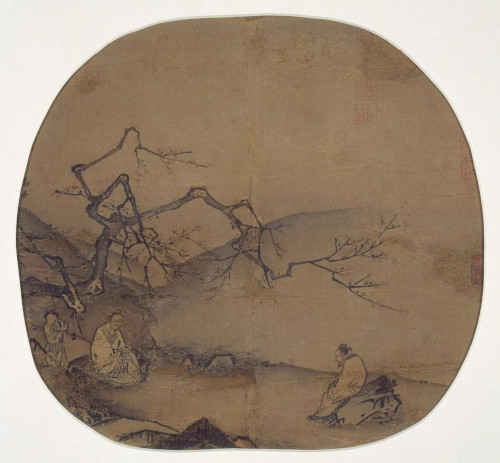
And as you can see pretty clearly, the silk has been folded up the middle at some point in its roughly 800 years of storage, and that fold -- like the hexagram Wing associates it with, and like the pages of Blue Planet Notebooks -- reinforces the bilateral composition of the image, underscoring the associated juxtaposition(s): the two sages, O'Gallagher and Pelieau, Colossus and Guardian. The medium is [a] message. I am not sure if O'Gallagher would have been aware of this painting and its association with ䷖, but ultimately, I think O'Gallagher clearly wants his reader to think of still another generative, "interfacial" juxtaposition and collaboration between humans and machines.
Permutation
Looking at the three pages permuting THERE IS ANOTHER SYSTEM in distinct ways, it is interesting to think about what "computer-generated" means for O'Gallagher.
The concept for using permuting a phrase to generate poetry follows a mathematical principle, but it is most easily executed on a computer. It is, therefore, reasonable to include Brion Gysin's compositions in this modality among the history of computational literature, even if he originally composed these works manually. Since the number of permutations for any sequence is the factorial of the number of tokens in that sequence, a 4-word phrase contains the potential for 4! or 24 rearrangements (4 x 3 x 2 x 1 = 24), and a 5-word phrase, 120 permutations. Calculating these by hand would be tedious, but certainly possible.
In the early 1960s, Gysin collaborated with Ian Sommerville to use a computer -- likely the EDSAC 2 at Cambridge University, according to David Pocknee's excellent website about Gysin's permutations -- to generate these poems.
Nick Montfort has also implemented a web-based demonstration of Gysin's permutations, and I made a (now defunct) Twitter bot for this purpose, @PERMUTANT. I also made a webpage to help visualize the permutation algorithm, but Pocknee's comparative demonstration is far better.
Lillian-Yvonne Bertram has also implemented permutation in one of the poems in their 2019 collection, Travesty Generator. As I discuss in an essay now published in Digital Humanities Quarterly, Bertram modifies a program Montfort originally created for his book, #!, such that Bertram's version, "three_last_words" -- which memorializes the final words of Eric Garner (and, unfortunately, many other victims of police violence) -- will generate a memory error on the system running the program.
The implementation of permutation is significant, but for O'Gallagher, the idea of permutation seems significant. He was certainly aware of Gysin's work (O'Gallagher corresponded with Gysin's collaborator, William S. Burroughs, and his work was published in the same avant-garde circles), but O'Gallagher's interest seems to lie more in the concrete poetics of permuting a phrase than in the audial or conceptual characteristics.
In the first iteration, the page is filled by the words of the nominal phrase, but that phrase only appears once, at the top left of the page. Since there are 24 valid permutations of the four-word sequence, one would expect that phrase to appear at least one more time, but upon closer inspection, it appears that the words are simply printed randomly. If the phrase were being shuffled randomly -- as appears to be the case for the subsequent iterations -- then it would be impossible for the same word to appear three times in succession, but a quick glance through the page reveals many such instances.
The large word REPEAT across the middle creates an impression of figure and ground, so the randomized words serve as background static. REPEAT is set in a typeface called Moore Computer that is among several fonts affecting computational origins. This font -- along with Data 70, Amelia, and Orbit-B, all of which are used elsewhere in Blue Planet Notebooks -- are among a group of fonts with unnecessarily large serifs intended to echo the look of E-13B, a font developed in the 1950s for magnetic character recognition.
As I wrote about in my dissertation, it is ironic that the aesthetics of this font account for the physical characteristics of magnetic ink and are, therefore, working at the interface between an ink and paper inscription and a digital record. In other words, there is no technical reason for a font with these massive serifs to appear in a screen-based font, but it happens frequently in science-fictional settings. In Colossus, Moore Computer appears in the implied heads-up-display representing Colossus's point of view:
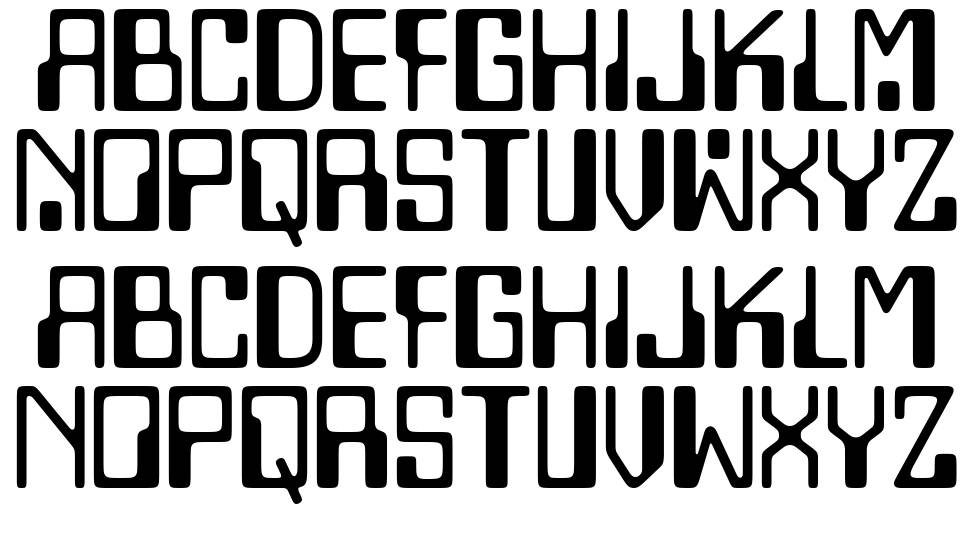
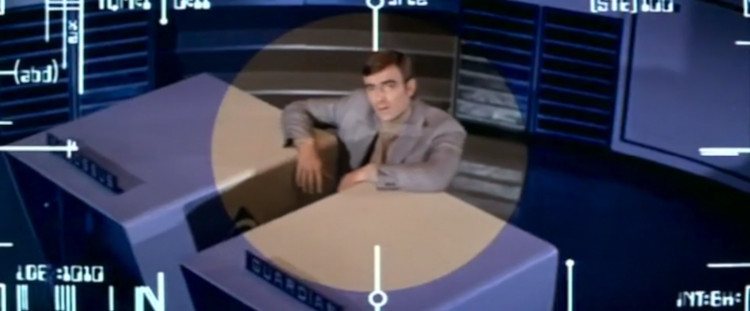
So even though the words on O'Gallagher's page are not, technically, permutations, it is still a work of computational poetics. The words may be random, but their randomness seems to be the result of computational pseudorandomness. O'Gallagher acknowledges the support of Richard Friedman (who worked in radio for many years, including this fascinating interview with John Cage) and "C.E.T.I." for the "computer printouts." These words are indeed printed in a teleprinter typeface (I'm not sure which), but a snippet from a Fortran program that accompanies a later work ("CIN-TAX-CIRCUIT) lists control blocks for "LIAM", "PRMUT", "PRNT", and "RAND". No functional code is included, but the variable assignments and memory addresses for subroutines imply that some significant computation was involved.
For the second and third iterations of THERE IS ANOTHER SYSTEM, the presentation still involves some kind of randomness, but thanks to the monospace font, the arrangement of words in solid columns accomplishes a different meaning. In a book where nearly every page involves multiple fonts, unconventional typography, and very few consistent visual elements, these two pages stand out for their frank rigidity.
{a couple of more 'typical' pages}
Still, these pages involve computational methods. As before, they appear to imply permutation (a deterministic algorithm) while in fact relying on aleatory composition. In the second iteration, the four words' order is scrambled, and in the third iteration, each word occupies the same position, but its letters are randomized. Neither of these exhibit any of the specific sequences that would have been generated by any of the five algorithms in Pocknee's interactive demonstration.
Instead, the sequences are -- to my eye, at least -- random. Since there are 24 possible permutations of the phrase, and the page includes 204 instances of the sequence, a deterministically-derived sequence would lead to it being distributed regularly and appearing exactly 8 times. Instead, it appears 9 times, and seems to be distributed unevenly.
Still, it is possible that the Fortran program first generated the 24 permutations, randomizing the order of those permutations before adding them to the page. The original phrase appearing 9 times is consistent with that hypothesis, but the recurrence of "THERE SYSTEM IS ANOTHER" three consecutive times in the first column makes that unlikely.
For the final permutational page, versions of the phrase again seem to be distributed randomly within the 204 iterations, but the visual effect is more striking in its illegibility. With 120 possible permutations of T-H-E-R-E, its appearance as "THERE" four times is slightly more than one would expect, but with 720 and 5040 for SYSTEM and ANOTHER respectively, their absence after the initial statement is not surprising.
Conclusions
In Blue Planet Notebooks, so much is happening and moving in different directions that it is difficult to narrow it down to a specific claim or poetic idea. Indeed, that sense of chaotic energy seems to be O'Gallagher's main interest. Occasionally, however, O'Gallagher writes with the energy of a manifesto, as in the essay(?) that centers AESTHETIC ANARCHY and expounds on its meaning.
When I look at historical examples of computational literature and art, I am always interested to learn what they have to say for our present moment when the imbrications of human creative work and generative AI carry apocalyptic urgency, so I was struck by the call for boredom and malaise in the following passage. (NB: This is an excerpt, but the syntactical idiosyncrasy is present in the original, suggesting a cut-up method on the part of the author.)
made to our image & likeness--computers in linear & parallel forms of communication are trying to find that great diagonal line that cuts across the sky to let--the sunshine! in shaping the future of new worlds we must include computers, as we were included, in some form of symbiosis [...] "the greatest surprise would be the absence of great surprise." to an anarchist (aesthetic) paradox is not unfamiliar, in order to mediate opposing forces...it is the life experience. birth & death may no longer be surprises & so it becomes necessary to discover the new sources of malaise in the electronic age and to invent a feature, in yet, another dimension.
This surely isn't what O'Gallagher had in mind, but it makes me think of the impression -- shared by many -- that generative AI since GPT-3 is, by and large, fairly boring. In an "If, then" workshop recently, someone (I forget who) observed that GPT-2 was the last text generator capable of generating real surprise. To paraphrase Nora Reed (I'm pretty sure this was her, but I can't find the post) GPT-2 could get weird in interesting ways, but chatGPT writes like a business major.
For my part, I read O'Gallagher calling us to pay attention to what we find boring so that don't make the mistake of accepting those particular symbioses as our aesthetics. A challenging proposition, indeed.
There's a lot more to talk about from this book, including the theme of space travel and various motifs involving video and television technology. If nothing else, I hope this post has helped bring great awareness to Liam O'Gallagher's work, which I found to to be fascinating and well ahead of its times in many ways. As a work of computational literature Blue Planet Notebooks still reads well today, and I encourage anyone studying or teaching computer-generated literature to check it out.
And maybe we can take "THERE IS ANOTHER SYSTEM" as a reminder to embrace the aesthetic anarchy and chart new dimensions through the technological symbiosis of contemporary generative AI.
Word Count: 3324